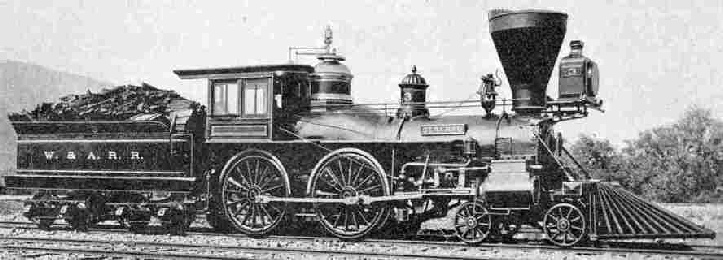
© Railway Wonders of the World 2012-


The “General”
The historic American Civil War engine

THE 4-
THE locomotive “General”, shown in the illustration above, was built by the Rogers Locomotive Works in 1855 for the Western and Atlantic Railroad, U.S.A. This engine, which became historic by reason of an astonishing adventure through which it went, was a 4-
During the American Civil War between Northern and Southern States, the Western and Atlantic main line between Atlanta and Chattanooga was a vital route to the Southerners or Confederates, and therefore was considered specially worthy of destruction by the Federals, as the Northern men were called. To this end Captain James Andrews of the Federal Army and a picked company of 21 men managed to make their way in disguise far down behind the Confederate lines. Their object was to capture a train, and use it for a grand destructive tour of the. Western and Atlantic. This was on 12th April 1862, and the train they picked on happened to be the 6.0 a.m. from Atlanta to Chattanooga. drawn by the 4-
Fuller, with Engineer Cain and Shop-
Now Andrews’ proceeding was a tremendous game of bluff. To prevent pursuit or interception he stopped the “General” periodically, blocked or destroyed a length o track, and cut the telegraph wires. At wayside stations officials and soldiers were told that this was a special trail conveying munitions to the Confederate General Beauregard, and the bluff succeeded.
Fuller was determined to recover his train, however and also to prevent Andrews from having time enough to do any major damage. The turning of the tables began when he came up to the freight engine “Texas”, which he detached from its train and pressed into tin pursuit, running tender first. He came within sight of the purloined “General” just as Andrews and his company were giving some further attention to the telegraph wires. Andrews and his men mounted the “General” and set off in a hurry, leaving one of their freight cars in Fuller’s way.
Twice they did this, and both times the “Texas” picked up the car and pushed it ahead of their tender. This close pursuit went on for many miles in the course of which Fuller was able to shunt the encumbering cars into a siding. Andrews, in his turn, had knocked out the end of his remaining car, the better to throw out obstructions while running. Again and again Fuller caught hint up, however, and at last he was obliged through failing water and fuel, to abandon the “General”. His men set their car on lire and reversed the engine, but in their hurry they forgot to release the handbrakes, and the intended collision failed to take place. They were all captured, and Andrews and several of his companions were executed.
Thus was the “General” recovered, after a chase covering something like 90 miles.
You can read more on “The Railway in War”, “Railways at War” and “Railways at War -